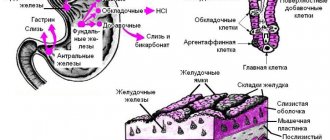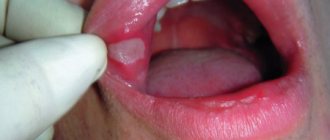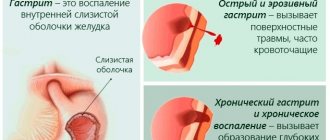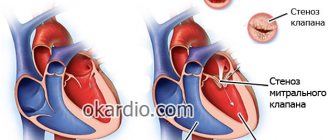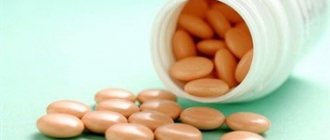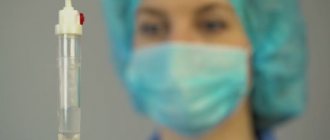The ability to identify the symptoms of gastritis with low acidity, knowledge of treatment methods and diet are the basis for recovery. The pathology is an inflammation of the gastric mucosa, accompanied by reduced acidity of gastric juice, as well as a reduced ability to break down food. Gastritis with reduced acidity negatively affects the entire body.
Related articles:
Atrophic gastritis and its symptoms, causes and treatment Find out what are the symptoms of exacerbation of gastritis and how to treat Which doctor treats gastritis, who should I contact? Find out what you can eat if you have gastritis What is hyperacid gastritis - its symptoms and treatment
Important! With low acidity, intestinal infections easily penetrate the digestive system and cause inflammation.
General information
Gastritis with reduced secretion is characterized by inflammatory processes that occur in the gastric mucosa. This pathology is caused by low acidity of gastric juice or a decrease in its ability to break down consumed food. This type of disease often affects:
- middle-aged people;
- elderly;
- those who drink alcoholic beverages excessively;
- lovers of spicy or fatty foods.
Treatment of pathology is aimed at normalizing the functions of other organs of the digestive system, preventing the development of atrophic processes, and restoring the secretion of the gastric glands.
Tablets for superficial gastritis
The cause of catarrhal or simple gastritis is poor-quality food, so treatment begins with washing the patient’s stomach with warm water and inducing vomiting. In case of mild household poisoning, it is recommended to take adsorbent drugs - Smecta, activated or white carbon. Such products bind toxins and promote their removal from the body.
Tablets for superficial gastritis are prescribed in rare cases. As a rule, they are used in combination with each other. Popular treatment regimens:
- To eliminate the bacterial factor, antibiotics with an anti-inflammatory effect are prescribed. Such medications for gastritis are available primarily by prescription and require strict adherence to dosage. Frequent combinations of antibacterial agents are Clarithromycin + Metronidazole, Amoxicillin + Clarithromycin.
- When the acidity of the stomach increases, the drug Venter is used. The active component of the product is sucralfate. It binds to the proteins of dying mucosal tissues, forming a protective film and reducing acid levels. The standard dosage is 1 tablet 3 times a day. Side effects often include nausea, vomiting, dizziness, and drowsiness.
- Enveloping agents are used as educational medications. For example, Almagel suspension with active ingredients – magnesium hydroxide and algeldrate. The medicine neutralizes hydrochloric acid and protects the gastrointestinal mucosa from damage. You need to take Almagel half an hour before meals, 1-3 dosed spoons 3-4 times a day. Occasionally, the medicine may cause taste disturbances, cramps, and nausea.
Symptoms
It is often problematic to recognize gastritis with low acidity on your own; the symptoms are varied and can change during the development of the pathological process. In the early stages of the disease, a person experiences heaviness in the epigastric region and dull pain. Along with these unpleasant symptoms, the following occurs:
- nausea;
- rumbling in the stomach;
- increased gas formation;
- unpleasant taste in the mouth;
- vomit.
The presence of gastritis is also indicated by a white coating that forms in the central part of the tongue. In the absence of proper treatment, the following are added to the main symptoms:
- disruption of metabolic processes occurring in the body;
- increased fatigue;
- dry and brittle hair;
- sleep disorders;
- headache;
- decreased performance.
The skin of a person suffering from gastritis with low acidity becomes dry, and pockets appear in the corners of the lips. The chronic form of the disease is characterized by the appearance of secondary symptoms:
- rapid heartbeat, which occurs after eating;
- dairy intolerance;
- general weakness;
- dizziness;
- heartburn caused by the accumulation of organic acids in the esophagus or stomach;
- metallic taste in the mouth;
- increased salivation.
After taking enzyme medications, the symptoms of the disease partially disappear. But after cancellation they arise again.
List of medications for gastritis with high acidity
What medications to take during an exacerbation of the disease depends on the symptoms. With minor manifestations of the disease - dull pain in the sternum, heaviness, nausea, unpleasant taste in the mouth, general weakness - taking antacids or alginates is quite enough. At the same time, you need to follow a diet, drink a lot of still mineral water, and warm milk.
- Almagel and Almagel A in the presence of pain;
- Maalox;
- Rennie;
- Gaviscon;
- Gastal;
- Phosphalugel;
- Smecta.
If there is severe heartburn, belching, nausea to the point of vomiting, prokinetics, gastroprotectors, and antisecretory agents are required. Approximate treatment plan:
- Omez – 1 time per day;
- Almagel – 4 times a day;
- Domrid with prolonged action - 1 tablet per day.
To reduce acidity and speed up the action of the tablets, it is recommended to drink at least 1.5 liters of mineral water per day or 4 glasses of warm milk. Additionally, it is recommended to take drugs from the group of probiotics, for example, Hilak Forte. The product normalizes acidity, increases the body's protective functions, and restores microflora. Also, you should take vitamin complexes that increase energy potential and help fight the disease.
Reasons for the development of the disease
Gastritis with low acidity occurs due to external and internal factors. The most common causes of the disease are:
- the presence of pulmonary pathologies and, as a result, a decrease in the amount of oxygen entering the body;
- violation of the diet (eating too rough, hot food with spicy seasonings);
- abuse of drinks that contain alcohol;
- circulatory disorders and diseases of the cardiovascular system;
- autoimmune pathologies;
- endocrine diseases;
- concomitant diseases of the digestive system - enteritis, colitis and others.
Helicobacter pylori infection, which functions in the body for a long time, can also lead to atrophy of the gastric mucosa. Microorganisms that initiate inflammation in the epithelium cause cell damage.
Complete absence of symptoms
In isolated cases, the only sign of gastritis with low acidity is an unpleasant odor of unknown origin from the oral cavity. The patient may not be aware of the root cause of this phenomenon and try to find a solution to the problem in the dentist’s office. But with hypoacid gastritis, removing dental plaque and sanitizing all teeth does not help get rid of the smell. The cause of bad breath in this case is pathogenic bacteria that actively multiply in the digestive tract. Over time, dysbiosis is diagnosed.
Types of gastritis
It is not enough to simply identify the presence of gastritis with low acidity; the doctor can prescribe treatment only after determining the type of the disease:
- Atrophic is characterized by thinning of the mucous membranes of the stomach, tissue death, and loss of their protective functions. If the level of acid in the stomach decreases significantly, then this condition will lead to the development of cancer. It is impossible to establish the exact cause of the development of such a pathology, but experts are inclined to believe that poor nutrition, overeating and uncontrolled use of antibiotics and hormonal drugs are to blame.
- Chronic is divided into several stages - decompensation, partial compensation and compensation. This type of disease develops slowly: first, the level of acid in the stomach increases. If left untreated, the cells responsible for producing acid begin to die. As a result, the acid level is normalized. The progression of the pathology leads to the death of the mucous membrane and the development of a chronic version of the disease.
Causes of gastritis with low acidity
A decrease in the level of acidity in the stomach is often caused by diseases of the gastrointestinal tract. The functioning of the glands of the stomach lining and the cells responsible for the production of hydrochloric acid are disrupted.
The task of stomach acid is to disinfect food that enters the stomach, and its insufficiency indicates the likelihood of harmful bacteria entering the body.
Microorganisms provoke the continuation of the inflammatory process in the gastric mucosa.
The main causes of hypoacid gastritis include:
- Alcohol and smoking abuse;
- Presence of the bacterium Helicobacter pylori;
- Frequent consumption of foods containing spicy seasonings and salt, canned, smoked and fried foods;
- The presence of diseases of the digestive system, as well as endocrine diseases;
- Frequent use of medications that have side effects that affect the gastric mucosa;
- Diseases of the liver and pancreas.
Diagnosis of gastritis
Before prescribing medications, a gastroenterologist must confirm the presence of the disease in the body, determine its type and stage of progression. Diets for gastritis with low acidity or treatment with traditional medicine cannot be administered independently.
After visiting a doctor and conducting an initial examination, the patient is prescribed certain examinations:
- radiography, gastroscopy of the stomach;
- examination of gastric juice and feces;
- morphological studies and endoscopic biopsy;
- Ultrasound;
- blood test for enzymes;
- testing for the presence of pathogenic microorganisms.
The purpose of these activities is to make an accurate diagnosis, eliminating the possibility of confusing this pathology with a disease with similar symptoms. The results obtained enable the doctor to exclude the presence of gastritis with zero acidity, correctly prescribe therapy, and select the optimal nutritional plan.
Diagnostics
The diagnostic program for patients with low gastric acidity depends on the duration and manifestations of this syndrome. Its main components are:
- Direct determination of pH level in the stomach. Produced using the pH measurement method. In practice, special probe and pH measurements performed during fibrogastroscopy (FGS) have proven themselves to be the best. The first version of the study allows you to measure both instantaneous and acidity throughout the day. The second type of pH measurement is valuable because it provides reliable information about acidity in different parts of the stomach.
- Fibrogastroduodenoscopy (FGDS or FGS). It is mandatory for all patients with any stomach diseases. Allows you to evaluate structural changes in the mucosa and perform pH measurements.
- General analysis and biochemical blood test. They provide additional information about the state of the body, the degree of disorders caused by digestive disorders.
- Ultrasound of internal organs (abdominal cavity). It does not provide information about the state of gastric secretion, but allows one to determine concomitant diseases, the course of which may be affected by low gastric acidity.
Treatment of the disease
Complex therapy is the key to eliminating the symptoms of gastritis with low acidity and preventing the development of the pathological process. Treatment of the disease involves drawing up a rational menu and using several medications prescribed by a gastroenterologist.
Therapy begins with the choice of dietary nutrition. Preference is given to products that do not irritate the mucous membrane and stimulate the formation of juice in it. The menu for each day is compiled independently or with the help of a nutritionist.
The use of medications is aimed at stimulating the release of hydrochloric acid in the stomach. To increase the level of gastric juice formation, replacement therapy is prescribed by the attending physician - the patient is offered a treatment regimen that includes Abromin, Pepsin, diluted hydrochloric acid or Panzinorm.
Experienced doctors know how to treat gastritis with low acidity. They always include vitamin and mineral complexes in the general course. Taking it will prevent deficiency of useful elements in the body and strengthen the immune system.
Antibiotics are prescribed by a gastroenterologist only if the examination reveals that microorganisms are the cause of the disease. Physiotherapy, visits to sanatoriums and herbal medicine are effective in treating gastritis. If you are ill, you will have to adhere to the principles of dietary nutrition for a long time, because a balanced diet will avoid complications and normalize the functioning of the digestive system.
Gastritis with low acidity: reviews
Review No. 1: I had an appointment with the doctor. A diagnosis of gastritis with low acidity was made. A medication treatment regimen was prescribed along with a recommendation to adhere to a diet. Soon I felt relief. I took a course of medications, but I still continue to follow the diet.
Review No. 2: I started having gastritis quite recently. Constantly being busy at work, dry snacks and rare full meals led to this diagnosis. A terrible feeling of heaviness and pain in the abdomen forced me to consult a gastroenterologist. After examination, low acidity of gastric juice was revealed. In moments of acute pain, she took No-Shpu, and also drank Pepsin and a complex of vitamins to normalize the functioning of the stomach. I'm on a diet. The treatment helped, I will try to continue to eat healthy and regularly.
Review No. 3: Based on all the symptoms, I discovered that I had gastritis. Since this is the initial stage, I decided to try folk remedies. I drank aloe with honey for 21 days, and also made myself a decoction of rose hips. My health has improved significantly. My stomach stopped hurting after eating. If I continue to feel good, I won’t contact a gastroenterologist.
Treatment of gastritis is mandatory at any stage. The sooner the patient begins to take care of his health, the greater the chance of quickly restoring the gastric mucosa. Contacting a gastroenterologist is the best solution in this case.
Basic principles of dietary nutrition for gastritis
For any form of development of the disease, including chronic gastritis with low acidity, it is important to correctly prepare a diet for every day. A number of recommendations must be followed:
- Before each meal, drink 1 glass of mineral water;
- give preference to fruit juices, jelly, homemade berry compotes;
- include more fruits and vegetables in the menu;
- prepare food by boiling, stewing or steaming;
- eat food at the same time;
- avoid overeating;
- the interval between meals should not exceed 3 hours;
- exclude hot food, the temperature of the dish should not exceed 50 degrees;
- eat slowly, chewing food thoroughly.
Contraindications
Each medicine has its own contraindications. Antacids should not be taken in cases of severe renal failure, and antisecretory drugs should not be used if there is a risk of internal bleeding. Before actively using any medicine, you should carefully study the instructions and consult a specialist. Especially when it comes to children under 12 years old, pregnant and breastfeeding. A direct contraindication to each medicine, including folk remedies, is individual intolerance to the components. It manifests itself as an increase in unpleasant symptoms, rashes, and itching on the skin.
Sample menu for gastritis
When preparing a diet, it is important to choose the most gentle dishes. Attention is paid not only to the products themselves, but also to the choice of method of their preparation. Nutritionists allow patients with a disease characterized by low stomach acidity to give preference to stewing, boiling, baking or steaming dishes. The use of spices, oils and fats should be avoided.
The table shows an indicative menu, based on which you can create a diet yourself.
| breakfast | lunch | dinner | afternoon tea | dinner | before bedtime | |
| first day | oatmeal with milk and fruit, green tea/rosehip decoction | boiled egg with a slice of black day-old bread and butter | vegetable soup, buckwheat porridge with steamed chicken cutlet | banana and glass of juice | baked apple or pumpkin with honey, green tea | low-fat kefir with a spoon of honey |
| second day | oatmeal with water and banana, a glass of green tea | peeled sweet apple; low-fat kefir with a spoon of natural honey | fish soup and potato casserole | fruit, crackers or biscuits | baked chicken breast with cheese and vegetables | glass of fermented baked milk |
| the third day | oatmeal with milk and a glass of kefir | vegetable salad dressed with low-fat sour cream | pasta with steam cutlet and beet salad | juice/green tea with crackers or biscuits | boiled chicken fillet and baked vegetables | yogurt with crackers/biscuits |
| fourth day | baked apple with natural honey and green tea | low-fat cottage cheese with added banana | borscht with chicken, vegetable salad and mashed potatoes | a glass of kefir or rosehip decoction | boiled fish and mashed potatoes | kefir with croutons from yesterday's bread |
| fifth day | low-fat cottage cheese and tea | banana casserole with cottage cheese | chicken soup with buckwheat, durum wheat pasta, stewed vegetables | natural juice or green tea with marshmallows | baked fish with rice | natural yogurt without additives |
The principles of dietary nutrition for gastritis with low acidity must be followed for at least three months, which will allow the pathological process to be transferred to the stage of stable remission. Nutritionists recommend that patients establish a drinking regime. A patient with gastritis needs to drink at least 1.5 liters of clean water per day, preference should be given to mineral water.
Treatment of low stomach acidity
The complex of therapeutic measures for hypoacid syndrome of the stomach consists of the following components:
- Proper nutrition;
- Drug therapy;
- Treatment with medicinal plants and mineral waters;
- Normalization of lifestyle and elimination of potential causative factors.
Important to remember! Treatment for low stomach acidity must be comprehensive. Each of the components of this complex is of key importance at a certain stage of the treatment process. Compliance with the principles of dietary nutrition is a prerequisite not only during treatment, but also to prevent relapse of the disease!
Proper nutrition
By creating the right dietary regimen, you can reduce the consequences of a deficiency of hydrochloric acid in gastric juice and stimulate the parietal cells of the mucous membrane to produce it. The key rules to follow are:
- Organization of meals. Irregular nutrition in unprepared conditions is unacceptable. Each meal should take place regularly at the same time in a room with appropriate surroundings. For this, an amount of time is allotted during which a person can calmly eat food while sitting at the table. Be sure to pay attention to the presentation and appearance of the prepared dishes. All these elements have a stimulating effect to increase stomach acidity.
- Diet. It is recommended to eat 5-6 times a day with an even distribution of the daily ration. Overeating is strictly prohibited. It takes about 20-30 seconds to chew a portion of food taken into the oral cavity. Therefore, each meal should last at least 30 minutes.
- Method of cooking. No frying. It is best to prepare foods by boiling or stewing. Preference should be given to liquid, crushed, pureed dishes in a warm form. Rough cold or hot food is prohibited.
- Exclude from the diet: smoked meats, fats, marinades, seasonings, spicy, rich and fresh baked goods, whole milk, alcohol, coarse fiber and hard-to-digest proteins that contribute to increased gas formation.
- The basis of the diet: soups based on cereals and vegetables with the addition of lean meat and fish, steamed cutlets and meatballs, crackers and stale bread, cheese, cottage cheese, soft-boiled eggs, butter, casserole and omelet. Apples, fermented milk products, berries and juices from them (currants, raspberries, cherries, pomegranates, strawberries, rose hips, citrus fruits), quince, parsley, cabbage, honey, weak coffee and black tea can increase the acidity of the stomach.
- The order of transition of dietary tables. Nutritionists recommend the following diet options: at the time of exacerbation - diet No. 4 b, followed by a transition to No. 4. In the near future after an exacerbation, they adhere to table No. 5 or No. 2, if the patient does not have problems with the liver and pancreas.
Practical advice! Before the next meal, patients with low stomach acidity should drink about a glass of cold water 25-35 minutes before the next meal!
Drug treatment
If with increased stomach acidity the main direction of treatment is drug therapy, then with hypoacid conditions the situation is exactly the opposite. There are very few truly effective drugs that would solve the problem on the pharmaceutical market. Another important point when selecting the right drug is taking into account the cause of the decrease in acidity, the condition of the stomach and other organs of the digestive system. The differentiated approach to syndromic therapy, on which the treatment is based, is shown in the table.
| Direction of treatment | Drugs and prescription features |
| Drugs that directly increase acidity | Plantaglucide, acidin-pepsin, gastric juice, herbion gastric drops. As active components they contain synthetic or natural substitutes for hydrochloric acid, or plant substances that stimulate the production of their own. |
| Stimulation of restoration processes in the gastric mucosa | Actovegin, aloe, vitamins C and B, nicotinic acid. Prescribed for any type of low acidity of the stomach, except for its combination with cancer of this organ. |
| Protecting the mucous membrane from irritation and reducing inflammation | Almagel, Venter, phosphalugel. |
| Improvement of digestion processes | Preparations containing enzymes: Creon, Mezim, Festal, Pancreatin, Pancreazym, Pangrol. |
| Elimination of reflux and disorders of contractile activity of the stomach | Medicines: domperidone, motilium, motorix, metocloparmide, cerucal. |
Important to remember! Even against the background of low acidity of the stomach, ulcerative lesions of the duodenal mucosa can occur if the cause of their occurrence is not related to the level of secretion!
Medicinal plants
The following medicinal herbs and plants will help increase the acidity of the stomach:
- Blueberry. Parts of the plant such as berries and leaves are taken in the form of a decoction, fresh or dried.
- Plantain leaves. Taken in the form of a decoction or juice.
- Air. The most useful is an infusion of its roots as a stimulant of gastric secretion.
- Rose hip. A decoction of the fruits of this plant is used.
- Sagebrush. A decoction based on the herb wormwood is prescribed.
- Elecampane. It is used similarly to wormwood, as it contains bitterness.
- Cowberry. The healthiest fresh lingonberries. You can prepare compotes and fruit drinks based on it and decoctions from the leaves.
- St. John's wort. Infusions and decoctions of St. John's wort herb are used.
- Buckthorn. A decoction is prepared based on its branches.
- Yarrow. It can be used in the form of a decoction and alcohol infusion based on herbs.
- Rowan. A decoction of fruits and leaves is used as a medicinal component.
- Caraway. Its seeds increase the secretory activity of the stomach.
- Aloe. Fresh plant juice is most effective.
- Immortelle. A decoction based on herbs and flowers is used.
Important to remember! Herbs for low stomach acidity can be used separately, or can be combined as a collection. Herbal medicine is selected either individually, or ready-made medicinal preparations (stomach tea, gastrophyte) are purchased!
Mineral water
Properly selected mineral waters are effective not only for preventing exacerbations of diseases accompanied by low stomach acidity. They are used as an auxiliary, and in some cases even the main therapeutic agent. In hypoacid conditions, sodium chloride waters are most effective:
- "Mirgorodskaya";
- "Essentuki-4";
- "Novoizhevskaya";
- "Feodosia";
- "Shaambars No. 2."
The maximum therapeutic effect can be obtained from those mineral waters that are obtained from an underground source at the place of its outlet. Packaged water lacks most of its healing properties. Therefore, hydrotherapy is best carried out in the sanatorium-resort treatment mode.
Simple recipes
When creating a diet, you should choose easy-to-prepare dishes that will normalize the level of gastric juice secretion and restore good health.
Pancakes in the oven with added fruit
To prepare you will need:
- 150 g oat flour or crushed flakes;
- 150 g buckwheat flour;
- 100 ml milk, low-fat kefir or water;
- 1 chicken egg;
- sugar and salt (to taste);
- 150 g of any berries or fruits;
- vegetable oil.
Preparation:
- Mix the liquid with sugar, salt, buckwheat and oatmeal. Add vegetable oil.
- Chop the fruit and add to the batter.
- Prepare a baking sheet - cover with parchment or sprinkle with vegetable oil.
- Pour some of the dough onto a baking sheet and place in a preheated oven.
- Cook for about 5 minutes in an oven preheated to 180 degrees.
- Serve warm, adding low-fat sour cream or jam.
Dessert of cottage cheese and fruits
To prepare you will need:
- 500 g low-fat cottage cheese;
- 300 g low-fat sour cream;
- 30 g agar-agar or gelatin;
- various fruits and berries - kiwi, banana, strawberries, apples (to taste);
- vanilla, natural honey or sugar (to taste).
Preparation:
- Prepare according to the instructions on the agar-agar/gelatin package.
- Mix cottage cheese, sour cream and honey/sugar in a container.
- Add gelatin or agar-agar to the curd mass. To stir thoroughly.
- Prepare a mold with high sides and cover it with cling film.
- Pour in the mixture and refrigerate for at least 3 hours.
- You can decorate the finished dish with berries. Serve, cut into portions.
Sticking to a diet for gastritis with low acidity is not difficult. The main thing is to choose your favorite dishes and not be afraid to experiment.
Reviews
Dear readers, your opinion is very important to us - therefore, we will be glad to hear your feedback on medications for gastritis in the comments. This will also be useful to other users.
“Almagel always helps me with gastritis. I have been taking it periodically for 15 years. I have never observed any side effects. Always helps in a few days. Eliminates nausea and pain in just five minutes. If the acidity does not decrease within 3 days, I add more Omez. I’ve been taking this treatment for 2 weeks. If I have severe nausea, I also take Domrid. Within 10 days, all unpleasant symptoms disappear"
Karina.
“I like Gaviscon in action. After a course of antibiotics, my acidity increased and my stomach began to hurt. I took Maalox, but it didn't help much. I sucked Gaviscon in tablet form 3 times a day. Additionally, I took Motilac and Ranitidine."
Veronica.
Therapy with folk remedies
Alternative medicine offers many methods of treating the disease. The most effective recipes that will complement or replace medications:
- Lingonberry tincture. Brew the berries in one glass of boiling water and leave for 1-1.5 hours. Drink 30 minutes before meals.
- Alcohol tincture of unripe walnuts. 500 ml of vodka and 15 fruits are combined in a dark glass container. Leave for 15 days at room temperature.
- Burdock root infusion. Add a teaspoon of plant root to 400 ml of hot water. Infuses for 24 hours. Taken before meals, at least 30 minutes.
The effectiveness of treating gastritis with low acidity with folk remedies has been fully proven. Ask your doctor which option to choose for therapy.
The video describes in detail the causes and dietary nutrition for gastritis with high and low acidity:
Medicines for gastritis in children
Drug treatment of gastritis in a child should be carried out under the supervision of a specialist. The doctor prescribes medications based on painful symptoms, age, and individual characteristics of the body. In most cases, therapy is carried out using diet, herbal remedies, and traditional medicine.
For confirmed gastritis with high acidity, children are prescribed antacids:
- Megalac;
- Almagel;
- Phosphalugel;
- Maalox.
Prescribed from 6 months of age 3-4 times a day. The duration of therapy is from several days to a month.
In severe cases, Omez, Omeprazole, Omitox, Ranitidine, Zantac, Losek are prescribed to reduce the production of hydrochloric acid. For belching, heartburn, and nausea, Domrid in syrup and Motilium are recommended. To improve digestion, Colicid and Pancreatin are prescribed. At the same time, a course of probiotic therapy is prescribed - Laktiale, Laktovit, Hilak forte, Turbiotic. To rid a child of diarrhea and remove toxins, Smecta and Activated Charcoal are recommended. To eliminate pain, you are allowed to drink No-Shpu, Drotaverine.
Hydrochloric acid in the body and its functions
Hydrochloric acid is produced by the parietal cells of the stomach, the functioning of which is controlled by three components:
- gastrin - a hormone synthesized by the pyloric part of the stomach, cells of the pancreas and duodenum;
- histamine – a mediator of immediate allergic reactions;
- acetylcholine is a neurotransmitter that controls neuromuscular transmission.
Production of hydrochloric acid in the stomach
The synthesis of hydrochloric acid occurs as a result of stimulation of specific receptors. The aqueous hydrogen chloride formed as a result of stimulation performs many functions, the main one of which is to ensure digestive processes. Hydrochloric acid in small quantities is necessary for the curdling of milk and dairy products and the release of casein - complex protein molecules. It also causes swelling and denaturation of food substances (proteins, fats) for further breakdown and digestion by digestive enzymes.
Hydrochloric acid supports the acid reaction of gastric juice, necessary for the activation of pepsin, participates in the stimulation of glandular cells of the stomach, affects the functioning of the small and large intestines and the further absorption of food. Hydrogen chloride is also necessary for the prevention of infectious diseases of the digestive tract, as it has bactericidal properties and destroys bacteria that enter the human body through the mouth (for example, pathogens contained in sputum, which a person swallows when it is impossible to expectorate).
Functions of hydrochloric acid in the stomach
Video: The mechanism of secretion of hydrochloric acid in the stomach
Reasons for decreased acidity
The main reasons for decreased acidity are:
- heredity factor;
- metabolic disorders caused by decreased production of thyroid hormones;
- infection with fungal toxins or Helicobacter pylori;
- deficiency of zinc and a number of B vitamins;
- improper diet;
- alcohol abuse and smoking, leading to oxygen starvation of mucosal tissues;
- development of autoimmune gastritis;
- activation of the nerve receptors of the stomach by reflex effects coming from the gallbladder, as well as the female genital organs.
Foods with a predominance of carbohydrates are a weak secretion stimulant. A long-term carbohydrate diet causes a decrease in both acidity and digestive ability of juice.
The digestive ability of gastric secretions in relation to foods with excess fat is lower than meat foods, but higher than carbohydrate foods.
A decrease in acidity can be both a cause and a consequence of inflammatory processes occurring in the thickness of its walls.
General clinical picture
Symptoms of gastritis with low acidity are caused by impaired digestion, decreased barrier function (hydrochloric acid normally provides an antibacterial effect) and impaired gastric motility. This is where the patient’s main complaints arise:
- The appearance of belching is noted, with the smell of rotten eggs or rot. This is due to the fact that the stomach does not fully digest the food eaten, which begins to ferment.
- An unpleasant taste appears in the mouth. The feeling of bitterness in the mouth is associated with duodenogastric and gastroesophageal reflux. A metallic taste already indicates the presence of B12 deficiency anemia.
- Even when consuming small portions, the patient notices heaviness and distension in the stomach, which disappear on their own after some time. This is explained by a disorder of the motor function of the stomach: impaired ability of the proximal part to relax, weakened motility of the antrum (gastroparesis) and impaired coordination in the work of the stomach.
- After almost every meal, heartburn and pain in the epigastric region appear.
We recommend: Symptoms of exacerbation of gastritis
- Intestinal dysfunction develops: constipation or diarrhea appears, which is associated with disruption of the activity of enzymes responsible for these processes.
With severe secretory insufficiency, the following manifestations of the disease are also possible:
- After eating a meal rich in carbohydrates, severe weakness, dizziness, and sweating appear. These complaints are due to the fact that due to the low content of hydrochloric acid in the stomach, food carbohydrates quickly enter the small intestine, are absorbed into the blood and cause a large release of insulin.
- There is rumbling in the abdomen, severe flatulence (bloating) and unstable stool, which is caused by impaired intestinal function.
Among other signs that are not related to the functioning of the gastrointestinal tract, gastritis with zero acidity can be manifested by dryness and excessive brittleness of hair, splitting of nails and a decrease in hemoglobin in the blood. The patient quickly loses weight and experiences constant fatigue due to insufficient absorption of incoming nutrients from food. All these manifestations should lead the doctor to the idea that the patient is developing autoimmune gastritis with signs of B12-deficiency anemia.
Chronic gastritis with secretory insufficiency may be accompanied by the development of hypotension, which is characterized by a decrease in blood pressure. A characteristic feature is a violation of protein digestion processes (hypoproteinemia). People with low acidity of gastric juice involuntarily reach for acidic foods and those foods that promote the production of hydrochloric acid (brown bread, cabbage, spicy dishes). It should be noted that even after eating the food you want, relief does not come.
Nutrition for low secretion
With reduced gastric secretion, one of the components of complete treatment is diet. Milk, apricots, grapes, pears, as well as smoked meats, sausages and sausages should be excluded from the diet. You need to eat in small portions and often.
For breakfast, it is recommended to eat various porridges, mostly oatmeal or buckwheat, and white bread croutons. Meat should be consumed lean and cooked in a gentle way - boiling. Among fruits, apples are allowed; other fruits, except grapes and melon, are allowed in small quantities. Juices can be drunk diluted with water. Alcohol is definitely excluded.
Following a diet with low acidity can not only prevent, but also stop the development of complications in the stomach.
It is desirable to have the following products in the diet to increase secretion:
- cabbage;
- kefir, fermented milk products;
- apples;
- parsley;
- grapes (but without skin);
- juices;
- pomegranate;
- rose hip.
But even when using these approved products, it is better to start with small doses and observe the body’s reaction.
Digestive cauldron
The function of the stomach associated with the secretion of secretions is very complex and multi-stage. The percentage of acid in the gastric juice and the secretory capabilities of the stomach are a functional sign that depends on a huge number of factors. It is regulated by reflex processes that arise due to irritation of nerve endings located in different parts of the gastrointestinal tract. These endings play the role of peculiar “buttons” that are activated upon contact with food and release many hormones (histamine, acetylcholine) and digestive enzymes that are in complex interaction.
The walls of the stomach, duodenum and upper part of the small intestine, as food moves along, secrete special hormonal substances - gastrins, which are a “moderator” of the activity of glands located in the thickness of the gastric wall.
The proteolytic enzyme pepsin and hydrochloric acid are secreted independently of each other by special cells of the stomach. The role of hydrochloric acid in the process of gastric digestion is that it activates the enzymatic action of pepsin.
Medications
If you suspect that you have low stomach acid, the symptoms and treatment methods of which can only be explained by a doctor, it is imperative to take special medications. There are several types of drugs for this:
- drugs that increase stomach acidity: Ortho Taurine Ergo capsules or soluble drug Plantaglucid;
— juice-based herbal preparations: infusion of calamus, viburnum, anise, aloe, chokeberry or rose hips;
- if the disease is accompanied by inflammation of the mucous membrane, drugs that prevent a decrease in the level of hydrochloric acid in the gastric juice are indicated. These are, for example, Omeprozole, Ranitidine, various hepatoprotectors and pancreatic enzymes;
- To relieve spasms, take “No-Shpu” or “Spazmol”, and for nausea – “Metoclopromide”.
All medications must be prescribed by a doctor after the disease “low stomach acid” has been confirmed. Symptoms, treatment and diet for this disease are quite specific. And it is necessary to follow all the doctor’s recommendations so that the death of mucosal cells does not develop into stomach cancer.
Why does acidity decrease?
Hydrochloric acid is produced by special cells in the stomach. They always produce it in constant quantities. And the level of acidity depends only on the number of these cells or on the degree of neutralization of the acid.
If the functions of the gastrointestinal tract are disrupted, these cells can die. In this case, low stomach acidity is observed, the symptoms of which need to be known in order to begin treatment on time. For what reasons could this happen?
— Hereditary characteristics of the body.
— Poor nutrition, overeating, consuming large amounts of spicy, sour foods, coffee and alcohol.
— Some medications, such as antibiotics, antidepressants, diuretics or bronchodilators, can also cause a decrease in stomach acid.
— Constant stress leads to a decrease in the secretory functions of the stomach.
Physiotherapy
Physiotherapy is aimed at relieving negative symptoms, stimulating normal secretion, restoring gastrointestinal functions, eliminating disorders and strengthening the immune system. The following procedures may be prescribed:
- Mineral waters “Essentuki No. 4”, “Narzan”, “Karachinskaya”, etc. They drink according to a certain pattern. The first doses are 75-100 ml once a day. Gradually the dosage is increased to 250 ml. The water temperature should be from 20 to 25 degrees. You need to drink it in small sips, slowly, a quarter of an hour before meals. The course of treatment is one and a half months. Treatment can be repeated after six months.
- Magnetotherapy , which creates eddy currents in the mucosa. They provoke a large release of heat, dilate blood vessels and improve metabolic processes in tissues, blood circulation and respiration. One session lasts 15-20 minutes. The duration of treatment is from 10 to 15 procedures.
- Vegetocorrective treatment is a set of natural techniques. Aerotherapy is used for gastritis. This enriches the body with oxygen. The use of electrosleep improves performance and reduces fatigue. During sessions, low-frequency currents are used.
- Transcranial electrical stimulation relieves emotional stress, reduces pain, normalizes sleep and banishes feelings of fear.
- Anti-inflammatory methods help soothe irritated mucous membranes. Cryo- and UHF therapy can be used.
- Reparative and regenerative techniques are aimed at healing damage to the gastric mucosa. Ultrasound and peloid therapy can be used.
- Antispasmodic techniques (electrophoresis) are aimed at eliminating and reducing pain. Sessions last 20 minutes, the course of treatment is from 10 to 15 procedures.
- Paraffin therapy is warm applications on the body. They help dilate blood vessels, improve blood circulation and tissue metabolism. Reduce pain, relieve spasms, accelerate the resorption of internal scars.
- Sedative techniques are aimed at normalizing the general condition of the central nervous system. Salt and herbal baths are done.
- Immunomodulatory techniques increase the body's resistance to diseases. These include magnetotherapy of the thymus, LOC (laser irradiation), SMV (exposure to heat).
Additionally, therapeutic exercises may be prescribed. There are many exercises, but only a doctor can choose the right ones. Afterwards, the exercise therapy complex can be performed at home. Exercises are done daily, selected so that the body does not experience excessive stress.
How to recognize the disease
Some people may not realize for years that they have low stomach acid. Symptoms of the disease are often so subtle that they can easily be confused with a common illness. In order to make an accurate diagnosis, you need to visit a doctor and conduct a full examination. It is done using special probing of the stomach, ultrasound and blood, urine and stool tests. Based on all the data and a conversation with the patient about his well-being, the doctor will make a diagnosis and prescribe treatment. But in many cases, a person himself can understand that he has low stomach acidity.
Preventive actions
To prevent pathology with low acidity, it is recommended to follow a proper diet and not abuse junk food. People who frequently drink alcohol and smoke are advised to reduce their dose of harmful substances or stop using them.
If other gastrointestinal diseases occur, they must be treated immediately. To be completely sure about your health status, you should undergo a preventive medical examination once a year. This will reduce the risk of developing serious pathologies.
We recommend: How to drink cabbage juice correctly for gastritis?
What is stomach acidity and why is it needed?
Gastric acidity is an indicator of a certain level of hydrochloric acid contained in the stomach; it is measured by pH units of gastric juice.
A certain level of acidity is very important for the normal digestion process. In order for food to be digested, enzymes are needed. One of them is pepsin, which works only in an acidic environment. Next, to move the contents of the stomach into the intestines and subsequent absorption of this content, you need to neutralize the acid. There are two areas of the stomach - the body and the fundus - where it is formed by parietal cells, and the antrum - where it is neutralized.
The work of the entire system is interconnected, so disruption of any of the processes leads to disturbances in the digestion of food in general. The consequence is that signs of stomach problems appear.
If there is a complete loss of parietal cells (their atrophy), a situation arises that leads to the development of irreversible processes.
Symptoms
Low acidity in the stomach and its symptoms are similar to other diseases of the digestive system. Main symptoms:
- after eating a person begins to experience stomach pain;
- belching and bad breath;
- the onset of heartburn;
- flatulence, hiccups;
- stomach upset.
If a patient experiences such signs, it is better to consult a doctor. Only he can correctly diagnose and prescribe treatment. If the acidity has decreased and the patient is diagnosed with diseases of the digestive system, high-quality treatment is necessary. If the disease is prolonged, serious consequences may develop.
People with low acidity most often experience signs of anemia:
- problems with hair begin, they become dull and dry;
- the skin becomes dry;
- nails become brittle and peel;
- There may be a rash or acne on the skin.
If a person does not monitor his health and is not treated, this can lead to the following consequences:
- Hemoglobin in the blood becomes lower, which leads to a general loss of strength.
- Skin hypoxia (lack of oxygen in the skin) may occur.
As a result of these problems, a person may experience health problems, as well as nervous disorders.
Symptoms of low acidity do not appear immediately. But, nevertheless, if they begin to appear, you should immediately pay attention to this and consult a doctor.
Adjuvant Treatments
In addition to the main drugs, medications are used to treat the disease, eliminating unpleasant symptoms and normalizing the general condition of the body. It is necessary to maintain normal functioning of the stomach and intestines, eliminate pain and heartburn. Means of symptomatic therapy include:
- Antidiarrheals (Polyphepan). Slow down intestinal motility, accelerate the absorption of fluid by the intestinal walls. This helps to get rid of diarrhea quickly.
- Carminatives (Espumizan). Promotes the removal of intestinal gases, relieving colic and bloating.
- Antihistamines (Claritin, Erius). Prescribed for allergic reactions to antibiotics, they normalize immune reactivity.
- Sedative medications (Sanason). Eliminate irritability and nervousness caused by the occurrence of unpleasant signs of gastritis.
For advanced forms of gastritis, the treatment regimen is supplemented with hepatoprotectors (Essentiale Forte) and hormonal drugs (Prednisolone).
For the treatment of gastritis with complications
A set of therapeutic measures for gastritis with complications should include medications that act on several stages of pathogenesis at once:
- Antisecretory agents - Gastrozol, Lanzap, Pariet. These medications reduce the secretion of hydrochloric acid and gastric juice, and reduce inflammation of the mucous membrane. Such drugs are produced in tablets protected by a poorly soluble coating. Almost all of them are recommended to be taken in the morning, swallowed without chewing. Extremely rarely, antisecretory medications for gastritis can cause taste disturbances, a bitter taste in the mouth, and diarrhea.
- Gastrocytoprotectors – Ventrisol, Alsukral, Cytotec. Their goal is to protect the mucous membrane from aggressive gastric juice, chemical or mechanical damage. Most of these medications are taken with or before meals in dosages as directed. Undesirable side effects during treatment rarely occur in the form of nausea, vomiting, dizziness, and allergies.
Additional Information
Medicines are mainly used to eliminate disorders. In order to increase the effectiveness of drug therapy, the doctor prescribes physiotherapeutic procedures and herbal medicine. Treatment is recommended to be carried out in a sanatorium-resort environment, which allows you to achieve quick and lasting results, eliminating the likelihood of complications. The patient must adhere to dietary nutrition throughout the course of treatment and during the period of recovery of the gastric mucosa after the illness.
Gastritis with low acidity is a serious disease that requires timely treatment. The sooner measures are taken, the greater the chances of a positive outcome. It is best to consult a doctor when primary symptoms appear, who will prescribe effective treatment, rather than wait for the development of health-threatening complications that worsen the quality of life.
How to treat the disease
Only a doctor can prescribe medications after making a correct diagnosis. Indeed, often this condition develops due to concomitant diseases, without getting rid of which the low acidity of the stomach severely increases. The symptoms and treatment of this disease are rarely known to anyone other than doctors. There are very few medications for increasing acidity on the market. Treatment for low stomach acidity includes:
- a special diet that it is advisable to follow constantly;
- folk remedies are often used by those who have low stomach acidity. The symptoms and treatment of the disease, however, are well known only to doctors, and you should not take any decoctions without consultation;
— special medications are taken strictly as prescribed by the doctor. These could be tablets to improve the secretory function of the stomach or herbal bitters.
Secretion stimulants
Treatment of gastritis requires different types of remedies.
| Restoring secretion | “Caffeine”, “Papaverine”, “Eufillin”. |
| Preparations that contain potassium and calcium | "Panangin", potassium chloride, calcium gluconate. |
| Medicines that affect metabolic processes in tissues | · "Thiamin"; · "Pyridoxine"; · "Cytochorm S"; · "Riboxin". Preparations containing nicotinic acid - “Complamin”, “Nikoshpan”, “Nicotinamide”. |
To restore the functioning of the pancreas and gallbladder, choleretic and multienzyme agents are required.
Treatment
Treatment of the disorder is carried out through a set of measures, which includes:
- Folk remedies. They are based on the use of natural compounds, such as herbal decoctions.
- Taking special medications. Such drugs that increase stomach acidity help normalize digestion.
- Designed diet. The new diet includes foods that contain inhibitors, i.e. compounds that can increase the body's acidity level.
Such complex treatment should not be carried out independently, but only under the supervision of the attending physician who made the diagnosis. This medical specialist is a gastroenterologist.
Traditional methods
There are folk remedies that help eliminate low stomach acidity at home. Their significant drawback is that the agents used during the treatment process can cause allergic reactions to specific components.
It is recommended to increase the acidity of the stomach using folk remedies for elderly people who, due to certain disorders, cannot afford highly concentrated medications or a strict diet.
The most popular home remedies to normalize stomach acid production are the following foods and herbs:
- Honey and propolis . These products act as natural acid stabilizers. At the same time, to get rid of the disorder, you can eat any kind of honey; regular bee honey is also quite suitable. It should be eaten either in its pure form or diluted with warm water. In the second case, only 2.5–3 tsp is enough. per glass.
- Butter . It is also an effective product for normalizing acidity levels. It is advisable to eat it in its pure form, but to reduce the discomfort from consuming such a fatty product, you can dilute it in equal parts with honey. This should be done 30 minutes before each meal during the day.
- Plantain . You can consume plantain against low acidity in its pure form, adding it to salads, and also in the form of juice. For the second method, you need to grind the clean leaves of the plant in a coffee grinder or blender, and strain the resulting mass through cheesecloth. A decoction of plantain leaves is also suitable, the dry mixture for which can be purchased at any pharmacy.
- Milk serum. It should be drunk instead of ordinary water daily in large quantities, and the duration of treatment with this method is at least 90 days.
- Schisandra chinensis . Juice should be made from fresh berries of such a plant, and a decoction from dried ones.
Decoctions from the following plants also help:
- calamus;
- motherboard;
- rose hip;
- wormwood;
- dill;
- straw-colored flowers;
- yarrow;
- dandelion root;
- cowberry;
- chamomile;
- blueberry.
Is it possible to drink soda when an illness appears? It is allowed to be consumed in small quantities (1 teaspoon per glass) if unpleasant symptoms occur, such as heartburn. But you shouldn’t get carried away, because it gives only a temporary effect, and if consumed excessively, it can lead to the opposite result in treatment.
Increasing low stomach acidity with folk remedies should be carried out only if there are no allergic reactions to the listed components.
Drugs
In pharmacies you can find quite a lot of drugs aimed at reducing the level of acidity in the body, while there are very few drugs to cope with the opposite ailment.
If the level of acid produced is insufficient, gastroenterologists often prescribe patients a special diet and prescribe medications that can eliminate the negative symptoms of low stomach acidity. As a rule, doctors prescribe the following pills:
- Omeprazole or Ranitidine. These remedies can cure inflammatory processes in the gastric mucosa, which may well accompany low acidity.
- Spasmol or No-Spa. Prescribed in case of stomach cramps.
- Metoclopramide. Relieves nausea.
However, there are drugs to increase acidity.
- Almagel. A popular drug that reduces stomach acidity.
- Protonix. A blocker of hydrochloric acid secretion, due to which normal acidity is formed in the stomach.
- Omez. The medicine inhibits the secretion of gastric acid; it is especially recommended to take Omez as an antiulcer drug.
- De-Nol. It is used for gastrointestinal ulcers and pancreatitis.
The essence of pathology
Reduced stomach acidity indicates the presence of abnormalities and malfunctions in the body. Before starting treatment, you need to find out the cause of the pathology. Otherwise, therapy and diet will not provide the desired results.
Gastric juice is a special catalyst for the digestive process. Its synthesis is carried out by a specific element located on the walls of the stomach. The composition of gastric juice is complex. The main component is hydrochloric acid, which is responsible for the level of acidity in this organ. Acid performs important functions in the process of digestion and absorption of food. It is able to fight pathogenic bacteria and disturbed intestinal microflora. A reduced level of acidity contributes to disruptions in the digestion of food, so it is important to determine the reducing factor.
With low acidity, food penetrates into the stomach cavity and cannot be fully digested. As a result, it decomposes and rots, which causes severe pain in the epigastric region. In addition, the removal of food from the gastric cavity into the intestine is disrupted. The processes of decay provoke vomiting, nausea, flatulence, and intoxication of the entire body. You need to see a doctor to determine the cause of your poor health.
After conducting a detailed examination, the attending physician will be able to prescribe a course of medication and a suitable diet. If you prefer to be treated with folk remedies, you need to discuss them with your doctor. As a rule, traditional medicine recipes are used in combination with traditional methods of treatment. As practice shows, consuming natural honey and propolis eliminates unpleasant symptoms and helps normalize acidity.
At the initial stage, low stomach acidity does not have pronounced manifestations. Basically, the patient is bothered by pain in the epigastric region and an unpleasant odor from the oral cavity. Some factors, diseases, foods and medications can reduce the concentration of hydrochloric acid. As a result, gastric juice becomes useless in the fight against pathogenic microorganisms and infections, which provokes the development of dangerous gastrointestinal pathologies.
Determination of acidity indicators
Low acidity does not have specific pronounced symptoms, therefore, if low acidity levels are suspected, the thoughtful analysis of the doctor, who focuses more on its consequences, and differential diagnosis come to the fore.
To characterize acidity, the so-called pH value is used. It contains the first letter of the chemical name of hydrogen, as it serves to evaluate the chemical activity of its ions (protons), which determine the acidity of liquid substances.
Important! Many are misled by the fact that the quantitative pH indicator increases with decreasing acidity of the environment: the higher it is, the less acidity. Normal stomach acidity has a pH value of 1.5-2. An indicator of 7 units is a watershed that conventionally separates an acidic environment from an alkaline one (this is an indicator of the acidity of pure water).
The most informative is the intragastric measurement of acidity using special sensors on an empty stomach and in different phases of juice separation and at different points of the stomach, since acid-secreting cells are unevenly distributed in the stomach cavity, their concentration is higher in its upper (fundic) part.
To make a diagnosis, a biochemical blood test is performed to detect antibodies to Helicobacter pylori and residual blood nitrogen. If necessary, an X-ray examination of the stomach and duodenum and an ultrasound examination of the gastrointestinal tract are performed.
Definition of the concept
Gastric juice is an integral element of the human digestive system, and is produced by cells of the mucous surface of the stomach.
This substance takes part in the breakdown of consumed food into nutritional compounds and microelements. Digestive juice has a complex composition, which includes hydrochloric acid. Thanks to it, the process of digesting food is carried out, and it is the level of hydrochloric acid in the stomach that determines its acidity.
The stomach, as an organ of the digestive system, has a large number of different glands, including bottom (tubular, fundic). They are located on the mucous surface of the walls and bottom, and regulate the increase in hydrochloric acid secreted. In order for acid secretion not to exceed normal levels, the stomach requires a specific number of tubular glands.
The stomach can be divided into two functional parts: acid-forming and neutralizing.
The production of hydrochloric acid by the bottom and walls of the stomach, and its neutralization before entering the intestine, occurs due to alkaline compounds.
Can acidity change? Of course, like any dysfunction of an organ, increased or decreased acidity leads to negative consequences, namely the death of cells that control acidity.
If the lining cells are completely destroyed, the stomach is susceptible to serious diseases. There are indicators that allow you to determine the level of acid in the stomach.
Table of acidity standards:
| Types of acidity | Acidity level in PH |
| On an empty stomach | 1,5-2 |
| Maximum | 0,86 |
| Minimum | 8,3 |
| In the antal region | 1,3-7,4 |
| In the epithelial layer | 7,0 |
Due to the fact that a sharp change in the acidity of gastric juice can lead to serious illnesses, the question often arises of how to normalize the acidity of the stomach.
